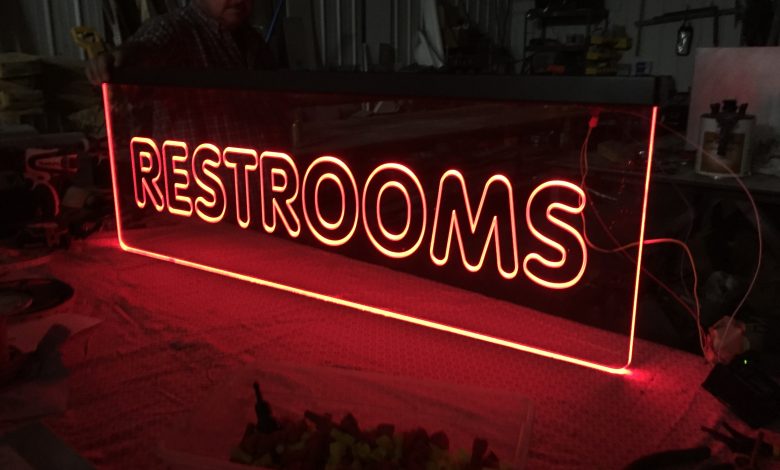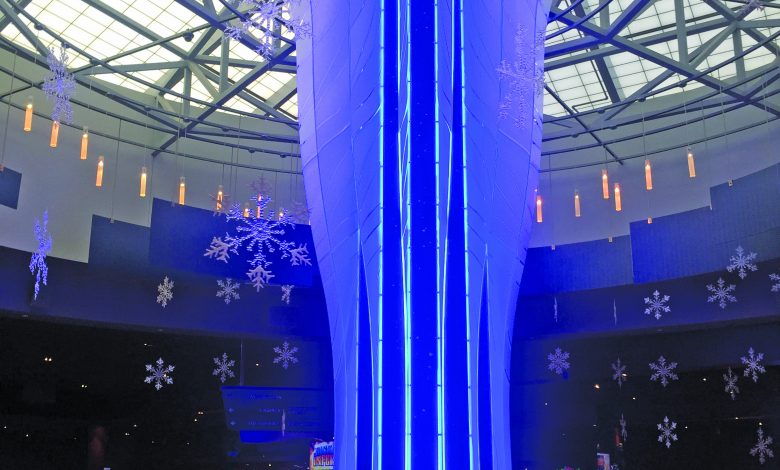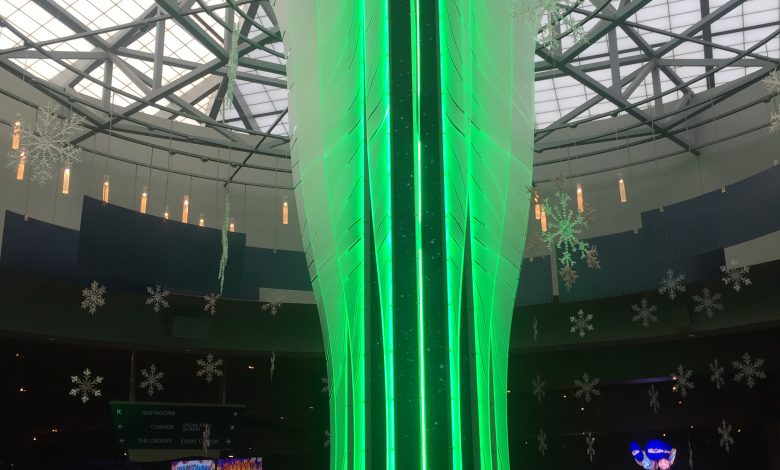LED Edge Lighting Solutions
Simple lighting solutions for keeping a display relevant and noticeable
Less is more. It’s a simple mantra that has been repeated for years, mainly because of its proven effectiveness. “Don’t overthink things” is another way of phrasing it. No matter how it is articulated, the practice of making a product functional and easy to use, without the unnecessary complications, is a benefit in the sign industry.
Edge lighting fits this description. It provides an excellent, inexpensive way to enhance a simple display using proven lighting technology and straightforward installation methods.
“Edge lighting is a low-cost way to make a sign 20 times better and more eye-catching than what it would be without it,” says Dan Parks, a sales representative with Principal LED. This type of lighting is very common, in fact, everyone has probably encountered it at some point in their everyday lives.
“Edge-lit technology comes from LCD monitor backlighting technology, and that’s how your computer and LCD TV can be seen,” says Hanna Huang, VP of business development at LEDCONN, a company that makes its own LED tape from scratch at the diode level.
Despite being an attractive, small-investment type of lighting option, there may be several questions that arise when considering edge lighting. In what situation is this type of lighting useful? How can it be implemented to reach its maximum effectiveness? How do the other signage display parts intermix with the lighting?
“There are several ways to ‘edge’ light signage, depending on the application and need,” says Fritz Meyne, Jr., vice president sales, Bitro Group, Inc.
Applications and benefits
The need for edge lighting is dependent upon a few factors. Sign makers should identify what type of display is being used in the project and determine how edge lighting elements would enhance the overall appearance.
Meyne outlines a couple of areas, saying, “Edge lighting a very thin five-millimeter advertising panel would typically be accomplished with a very small profile linear LED.”
The space required for the LED and the mounting location is minimal. “This would also include the depth for the LED, space, and the distance the light has to travel. And don’t forget to consider the power supply location and any potential code requirements,” adds Meyne.
So, the size and thickness of the display will impact which LED solution to include. Meyne continues by addressing the result of the added illumination, explaining that, “Edge lighting, like a halo effect, could be accomplished with individual modules or linear LED bars.”
Joe Reis, director of LED signage at International Light Technologies, points to some of these same factors when confronted with choosing an edge light solution. “Edge lighting is most effective in shallow applications,” he says, “six-inches and less, double-faced sign cabinets, P.O.P. edge light acrylic signs, snap-frame poster signs, and many more shallow applications.”
Because LEDs can be used in so many sign projects, edge lighting’s niche currently resides in these shallow applications as channel letters and lightboxes use LED illumination a little differently. However, that isn’t to say that edge lighting won’t see an oncoming growth period.
“Over the past couple years, we’ve seen more people adopt to edge light signage,” says Huang. “It’s not as popular as P.O.P. displays for retail lightboxes, but not everyone is going to be the first one to buy the newest Apple iPhone when it first comes out either. So, we are doing a lot of educating in the industry to infuse the idea. Still, there is a lot of room to grow and improve.”
The real benefit of adding edge lighting to a display is its ability to ramp up the overall look-especially with engraved acrylic signage. “Edge lighting makes a point-of-purchase sign pop, where before it was a plain, drab acrylic sign,” explains Parks. After adding LED edge lighting, “It essentially glows from within,” he says. “People can see it at night when you couldn’t before.”
And since there are many situations where edge lighting is applicable, it is useful in a number of different environments.
“It can really be used in any indoor application, whether in the lobby of a hospital, directional signage in an airport, or P.O.P. edge lighting is incredibly versatile,” says Parks. On top of that, it is an inexpensive option that dresses up a sign in an effective manner and, again, keeps the overall configuration simple.
“Compared to other options,” adds Huang, “edge lighting aesthetically looks nicer. From a fabrication side, it saves cost on the labor and materials, and it’s also helping to make the sign much more even. Plus, wiring is much simpler.”
Advancements
Technology frequently plays a part in how products can be improved in various settings. Even something as seemingly fundamental as edge lighting can be boosted to include state-of-the-art features.
“We try to optimize the lighting performance and provide a turnkey solution for the client, that’s our forte,” says Huang. “Sign fabricators like to make things on their own, they are so crafty and creative, but what we are doing is providing a turnkey solution. The acrylic in our products is an optical grade acrylic, it’s a Mitsubishi brand. On the back of the acrylic, we etch a dot pattern. That dot pattern is the light guide technology. Those little sign dots reflect light to your eye so you see the light in uniformity.”
With this type of product, a viewer sees a finer, widely-spread light when standing close to the display, then as he or she moves away from it, the light grows in size and intensity.
“We are able to help the sign makers make their signs much more glamorous,” says Huang.
Color changing is also a big difference-maker. It holds the advantage of switching the edge light from blue to red on-the-fly, for example, or simply creating a color scheme for a specific occasion.
“You can find RGB options, remotes, and dimmers for edge lighting applications, so you can accomplish whatever you envision,” says Parks. “We’ve seen users change colors for special holidays and months, like turning accent lighting pink for Breast Cancer Awareness Month in October.”
Having the capability of making these changes with a remote or even a motion sensor helps to capture attention in highly trafficked areas such as tradeshows or point-of-purchase locations.
A display’s light “can be (controlled) by dimmers, and/or DMX giving you a number of options for timing, brightness, dimming, and more,” Meyne says.
“You can add motion sensors that get brighter or dimmer, or allow color changing,” explains Huang. “Take a piece of white acrylic, when it’s not lit you won’t see anything, but when it is lit, you see an image popping up. Coupling that with a motion sensor, you get the ‘wow’ effect that’s really in your face. The image lives in our dot pattern. It’s all about how you apply that.”
Of course, the quality of the lighting is what really impacts the display, and sign makers should focus on the impact of the actual LEDs with edge-lit signage.
“I would say that the biggest advancement would be the efficacy of the LEDs,” says Reis. “I am able to get the same lumen output from 6.2 watts per foot as I was getting from 9.5 watts per foot. This also cuts the cost down in the quantities of power supplies needed.”
Meyne too points to the efficiency of LED products saying, “LED options only get better relative to performance/illumination, white K temp options, colors and even RGB.”
He also suggests that there is an energy-saving aspect to LEDs that helps both the sign maker and end-user feel comfortable; however, both parties should learn about any local or federal rules.
“Energy savings with most LEDs today are far superior to conventional options,” Meyne says. “However, there are some stringent WPF requirements in states like California, as an example, so that always needs to be understood.”
Enter the real world
It always helps to hear about actual examples when talking about potential projects that involve electrical components and general fabrication. When analyzing projects on the market and how they are assembled, sign makers can apply the fundamentals and add their own personal touches.
Reis recalls a monument sign job for Boston Scientific. “Edge illumination was the only application that would work to illuminate a one-inch thick by four-foot-tall by 24-foot-wide curved acrylic monument sign,” he recalls.
For projects that include edge lighting, Reis describes the process from a sign maker’s perspective. “Usually the sign makers would ask the LED manufacturer to suggest a product to correctly illuminate their sign cabinet,” he explains. “As an LED manufacturer, I look at the sign makers application and suggest the proper product for the desired illumination.”
As mentioned earlier, the tradeshow world is where many edge-lit applications can be seen. Principal LED recently used this type of lighting as an attention-grabbing element at its booth at a high-profile event.
“Our trade show booth at ISA 2018 featured an edge-lit acrylic monument,” says Kayla Kling, a member of Principal LED’s marketing team. “We used P-LED’s high-density Light Tape 600 to light it, and it turned out beautifully. Show attendees walked up to it in wonder, asking how it was lit. The piece was a great conversation starter.”
Describing the process of creating an effective edge-lit display, Parks explains, “The LEDs need to point toward the sign, so sign makers need to etch a groove along the edges of the sign so the LEDs can lay flush and face inward.”
Another way to achieve this look is to mount the lights externally to the frame and point them inward. “This second option lets you bypass etching a groove, since the LEDs are housed-and hidden-inside the frame instead,” Parks concludes.
Sign makers should know that they have choices with these displays. There are ways to set projects apart using even the slightest alterations. And of course, don’t overthink things.





